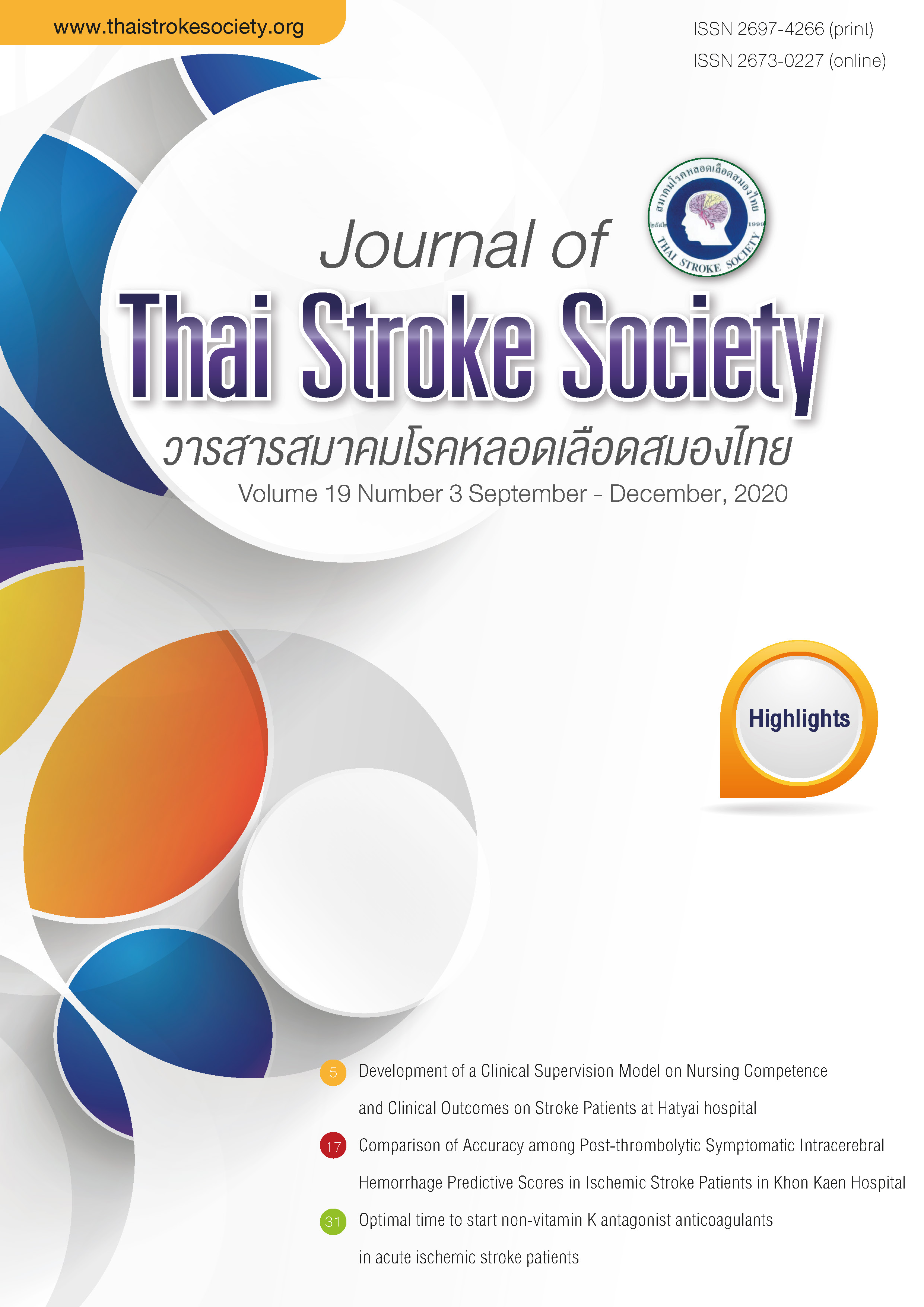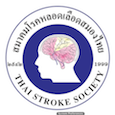Optimal time to start non-vitamin K antagonist anticoagulants in acute ischemic stroke patients
Keywords:
non-vitamin K antagonist anticoagulants (NOACs), non-valvular atrial fibrillation, acute ischemic stroke, cardioembolic strokeAbstract
Abstract
About 13-26% of ischemic stroke is caused by non-valvular atrial fibrillation (NVAF). Currently, there is no randomized-controlled trial (RCT) that supports when to start anticoagulant optimally. Risk of recurrent ischemic stroke is high within first few weeks of onset, however early starting anticoagulants increases risk of hemorrhagic transformation. Non-vitamin K antagonist anticoagulants (NOACs) which have been studied in the past 10 years have at least equal efficacy as warfarin in prevention of ischemic stroke caused by NVAF. Moreover, NOACs reduced cases of intracranial hemorrhage compared to warfarin. However, 4 landmark NOACs studies did not enroll acute ischemic stroke patients.
There are a few small trials studied risk and benefit of early starting NOACs in mild to moderate acute ischemic stroke from NVAF. The studies showed that early stating NOACs was less likely to increase risk of any intracranial hemorrhage. While starting NOACs later associated with increasing rate of recurrent ischemic stroke. Currently, there are several ongoing randomized-controlled trials that have power to answer
whether starting NOACs early or later after onset of acute ischemic stroke will be an ideal in terms of efficacy and safety.
References
2. Salazar CA, del Aguila D, Cordova EG. Direct thrombin inhibitors versus vitamin K antagonists for preventing cerebral or systemic embolism in people with non-valvular atrial fibrillation. Cochrane Database Syst Rev. 2014(3):CD009893.
3. Bruins Slot KM, Berge E. Factor Xa inhibitors versus vitamin K antagonists for preventing cerebral or systemic embolism in patients with atrial fibrillation. Cochrane Database Syst Rev. 2018;3:CD008980.
4. Heo JH, Lucero J, Abumiya T, Koziol JA, Copeland BR, del Zoppo GJ. Matrix metalloproteinases increase very early during experimental focal cerebral ischemia. J Cereb Blood Flow Metab. 1999;19(6):624-33.
5. Montaner J, Molina CA, Monasterio J, Abilleira S, Arenillas JF, Ribo M, et al. Matrix metalloproteinase-9 pretreatment level predicts intracranial hemorrhagic complications after thrombolysis in human stroke. Circulation. 2003;107(4):598-603.
6. Kassner A, Merali Z. Assessment of Blood-Brain Barrier Disruption in Stroke. Stroke. 2015;46(11):3310-5.
7. Paciaroni M, Agnelli G, Corea F, Ageno W, Alberti A, Lanari A, et al. Early hemorrhagic transformation of brain infarction: rate, predictive factors, and influence on clinical outcome: results of a prospective multicenter study. Stroke. 2008;39(8):2249-56.
8. Kirchhof P, Benussi S, Kotecha D, Ahlsson A, Atar D, Casadei B, et al. 2016 ESC Guidelines for the management of atrial fibrillation developed in collaboration with EACTS. Eur Heart J. 2016;37(38):2893-962.
9. Steffel J, Verhamme P, Potpara TS, Albaladejo P, Antz M, Desteghe L, et al. The 2018 European Heart Rhythm Association Practical Guide on the use of non-vitamin K antagonist oral anticoagulants in patients with atrial fibrillation. Eur Heart J. 2018;39(16):1330-93.
10. Powers WJ, Rabinstein AA, Ackerson T, Adeoye OM, Bambakidis NC, Becker K, et al. Guidelines for the Early Management of Patients With Acute Ischemic Stroke: 2019 Update to the 2018 Guidelines for the Early Management of Acute Ischemic Stroke: A Guideline for Healthcare Professionals From the American Heart Association/American Stroke Association. Stroke. 2019;50(12):e344-e418.
11. Powers WJ, Rabinstein AA, Ackerson T, Adeoye OM, Bambakidis NC, Becker K, et al. 2018 Guidelines for the Early Management of Patients With Acute Ischemic Stroke: A Guideline for Healthcare Professionals From the American Heart Association/American Stroke Association. Stroke. 2018;49(3):e46-e110.
12. Intercollegiate Stroke Working Party. National clinical guideline for stroke. 2016.
13. Ahmed N, Steiner T, Caso V, Wahlgren N, participants E-Ks. Recommendations from the ESO-Karolinska Stroke Update Conference, Stockholm 13-15 November 2016. Eur Stroke J. 2017;2(2):95-102.
14. Hart RG, Coull BM, Hart D. Early recurrent embolism associated with nonvalvular atrial fibrillation: a retrospective study. Stroke. 1983;14(5):688-93.
15. Paciaroni M, Agnelli G, Falocci N, Caso V, Becattini C, Marcheselli S, et al. Early Recurrence and Cerebral Bleeding in Patients With Acute Ischemic Stroke and Atrial Fibrillation: Effect of Anticoagulation and Its Timing: The RAF Study. Stroke. 2015;46(8):2175-82.
16. Hong KS, Kwon SU, Lee SH, Lee JS, Kim YJ, Song TJ, et al. Rivaroxaban vs Warfarin Sodium in the Ultra-Early Period After Atrial Fibrillation-Related Mild Ischemic Stroke: A Randomized Clinical Trial. JAMA Neurol. 2017;74(10):1206-15.
17. Seiffge DJ, Traenka C, Polymeris A, Hert L, Peters N, Lyrer P, et al. Early start of DOAC after ischemic stroke: Risk of intracranial hemorrhage and recurrent events. Neurology. 2016;87(18):1856-62.
18. Arihiro S, Todo K, Koga M, Furui E, Kinoshita N, Kimura K, et al. Three-month risk-benefit profile of anticoagulation after stroke with atrial fibrillation: The SAMURAI-Nonvalvular Atrial Fibrillation (NVAF) study. Int J Stroke. 2016;11(5):565-74.
Downloads
Published
How to Cite
Issue
Section
License
ข้อความภายในบทความที่ตีพิมพ์ในวารสารสมาคมโรคหลอดเลือดสมองไทยเล่มนี้ ตลอดจนความรับผิดชอบด้านเนื้อหาและการตรวจร่างบทความเป็นของผู้นิพนธ์ ไม่เกี่ยวข้องกับกองบรรณาธิการแต่อย่างใด การนำเนื้อหา ข้อความหรือข้อคิดเห็นของบทความไปเผยแพร่ ต้องได้รับอนุญาตจากกองบรรณาธิการอย่างเป็นลายลักษณ์อักษร ผลงานที่ได้รับการตีพิมพ์ในวารสารเล่มนี้ถือเป็นลิขสิทธิ์ของวารสาร





